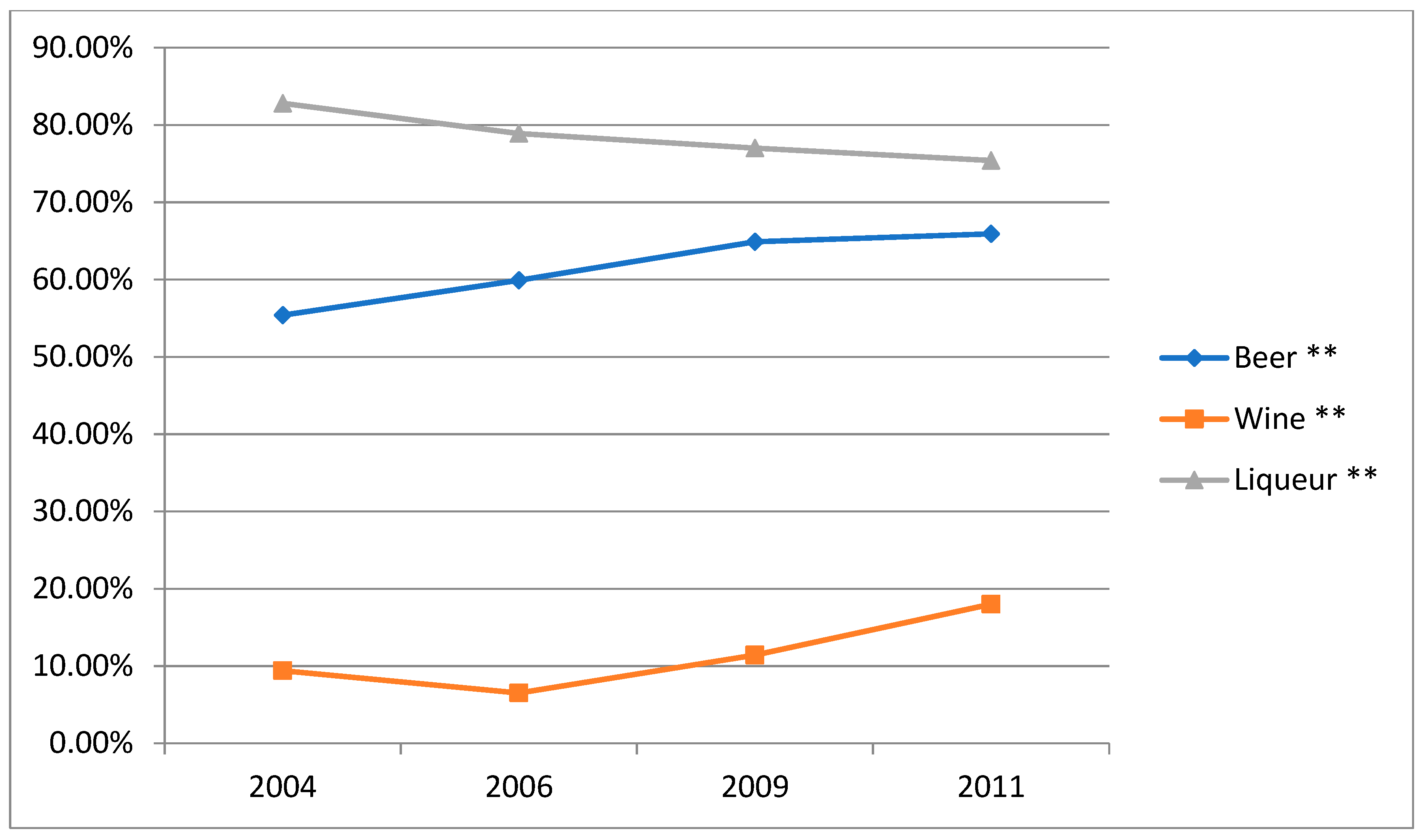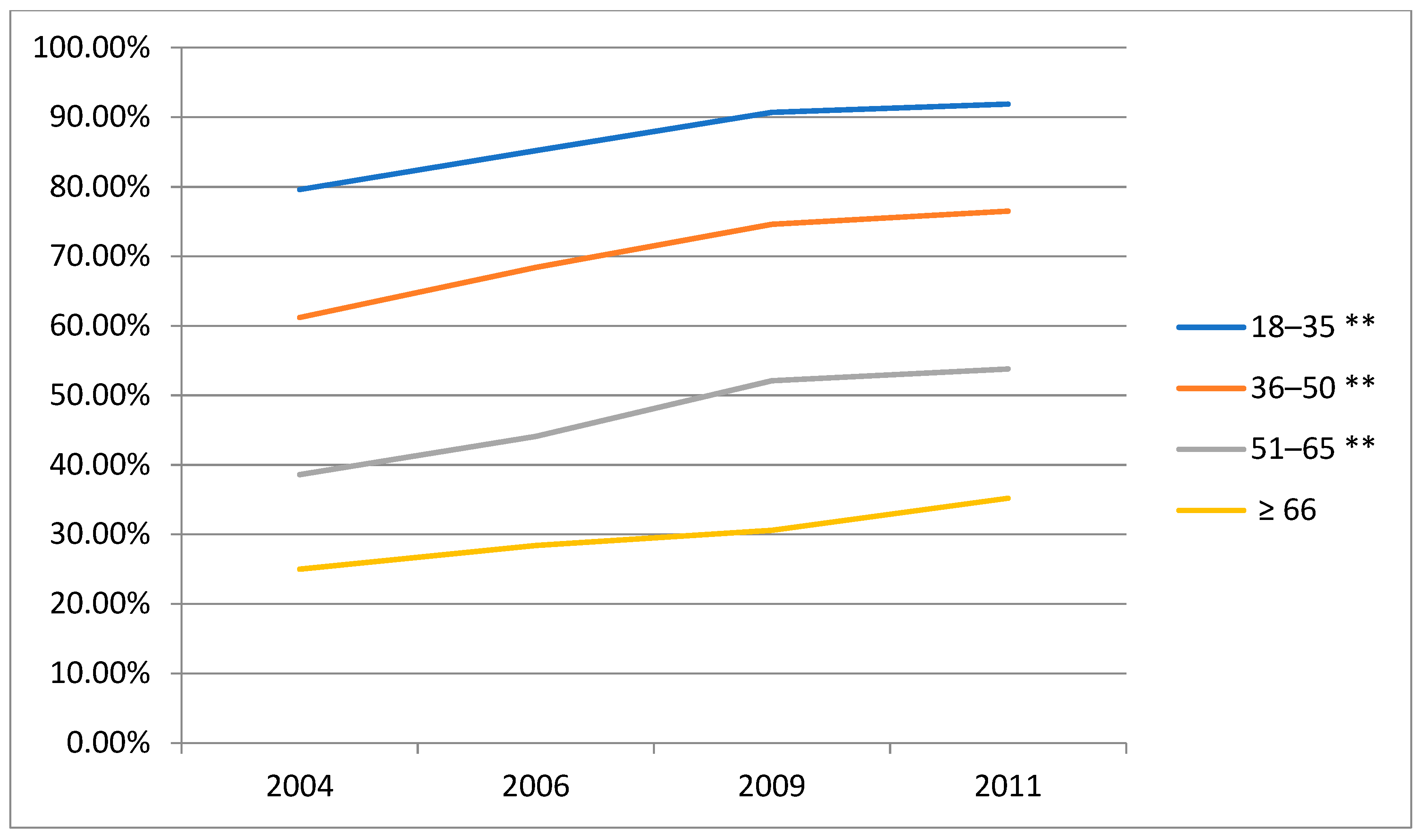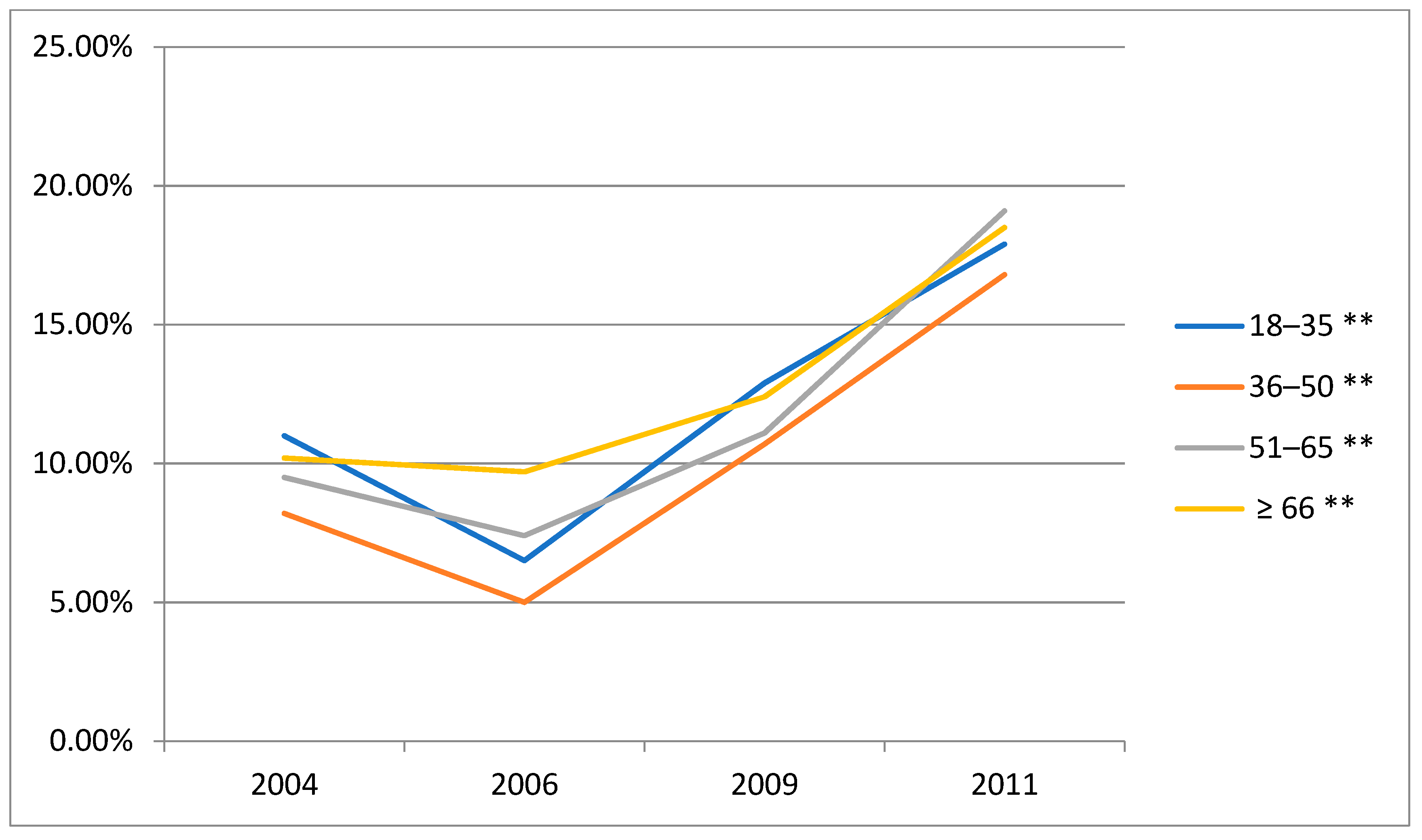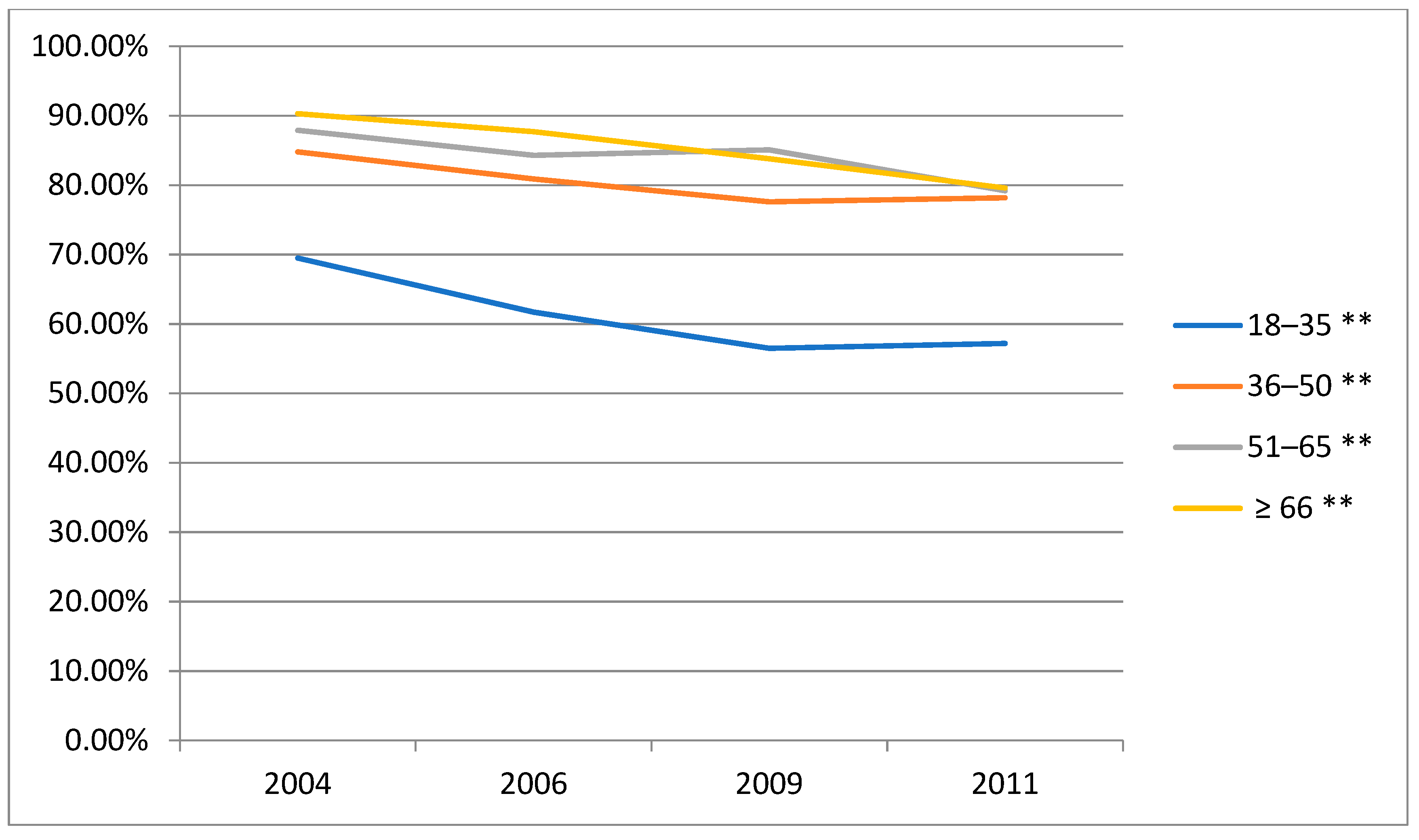Trends in Alcohol Intake and the Association between Socio-Demographic Factors and Volume of Alcohol Intake amongst Adult Male Drinkers in China
Abstract
1. Introduction
2. Materials and Methods
2.1. Study Design: CHNS
2.2. Alcohol Consumption
2.3. Socio-Demographic Variables
2.4. Data Analyses
3. Results
3.1. Characteristics of the Sample
3.2. Volume of Alcohol Intake in Male Drinkers
3.3. Trends in the Prevalence of the Different Types of Alcohol Consumption by Survey Year
3.4. Time Trends in the Prevalence of Alcohol Consumption (Beer, Wine and Liqueur) amongst Male Drinkers by Age Groups
3.5. Ordered Logistic Regression Model Analysis for the Volume of Alcohol Intake amongst Chinese Male Drinkers
4. Discussion
5. Conclusions
Supplementary Materials
Author Contributions
Funding
Conflicts of Interest
References
- Alcohol. Available online: http://www.who.int/news-room/fact-sheets/detail/alcohol (accessed on 24 October 2018).
- Xu, X.L.; Zhao, L.Y.; Fang, H.Y.; Guo, Q.Y.; Wang, X.; Yu, W.T.; Fang, Y.H.; Yu, D.M. Status of alcohol drinking among population aged 15 and above in China in 2010–2012. J. Hyg. Res. 2016, 45, 534–537. [Google Scholar]
- Rehm, J.; Mathers, C.; Popova, S.; Thavorncharoensap, M.; Teerawattananon, Y.; Patra, J. Global burden of disease and injury and economic cost attributable to alcohol use and alcohol-use disorders. Lancet 2009, 373, 2223–2233. [Google Scholar] [CrossRef]
- Ruidavets, J.B.; Ducimetière, P.; Evans, A.; Montaye, M.; Haas, B.; Bingham, A.; Yarnell, J.; Amouyel, P.; Arveiler, D.; Kee, F.; Bongard, V.; Ferrières, J. Patterns of alcohol consumption and ischaemic heart disease in culturally divergent countries: The Prospective Epidemiological Study of Myocardial Infarction (PRIME). BMJ 2010, 341, 1146. [Google Scholar] [CrossRef] [PubMed]
- Corrao, G.; Bagnardi, V.; Zambon, A.; La Vecchia, C. A meta-analysis of alcohol consumption and the risk of 15 diseases. Prev. Med. 2004, 38, 613–619. [Google Scholar] [CrossRef] [PubMed]
- Rehm, J.; Taylor, B.; Mohapatra, S.; Irving, H.; Baliunas, D.; Patra, J.; Roerecke, M. Alcohol as a risk factor for liver cirrhosis: A systematic review and meta-analysis. Drug Alcohol Rev. 2010, 29, 437–445. [Google Scholar] [CrossRef] [PubMed]
- Reynolds, K.; Lewis, B.; Nolen, J.D.; Kinney, G.L.; Sathya, B.; He, J. Alcohol consumption and risk of stroke: A meta-analysis. JAMA 2000, 289, 579–588. [Google Scholar] [CrossRef]
- Rehm, J.; Baliunas, D.; Borges, G.L.; Guilherme, K.; Lrving, H.; Kehoe, T.; Parry, C.D.; Patra, J.; Popova, S.; Poznyak, V.; et al. The relation between different dimensions of alcohol consumption and burden of disease–an overview. Addiction 2010, 105, 817–843. [Google Scholar] [CrossRef] [PubMed]
- Zhou, X.; Li, C.; Xu, W.; Hong, X.; Chen, J. Relation of alcohol consumption to angiographically proved coronary artery disease in chinese men. Am. J. Cardiol. 2010, 106, 1101–1103. [Google Scholar] [CrossRef] [PubMed]
- Huang, A.; Chang, B.X.; Sun, Y.; Lin, H.M.; Li, B.S.; Teng, G.J.; Zou, Z.S. Disease spectrum of alcoholic liver disease in Beijing 302 Hospital from 2002 to 2013: A large tertiary referral hospital experience from 7422 patients. Medicine 2017, 96, e6163. [Google Scholar] [CrossRef]
- Zhang, L.F.; Zhao, L.C.; Zhou, B.F.; Yang, J.; Li, Y.; Wu, Y.F. Alcohol consumption and incidence of ischemic stroke in male Chinese. Zhonghua Liu Xing Bing Xue Za Zhi = Zhonghua liuxingbingxue zazhi 2004, 25, 954. [Google Scholar]
- Bagnardi, V.; Rota, M.; Botteri, E.; Tramacere, I.; Islami, F.; Fedirko, V.; Scotti, L.; Jenab, M.; Turati, F.; Pasquali, E. Light alcohol drinking and cancer: A meta-analysis. Ann. Oncol. 2013, 24, 301–308. [Google Scholar] [CrossRef] [PubMed]
- Scoccianti, C.; Cecchini, M.; Anderson, A.S.; Berrino, F.; Boutron-Ruault, M.C.; Espina, C.; Key, T.J.; Leitzmann, M.; Norat, T.; Powers, H. European Code against Cancer 4th Edition: Alcohol drinking and cancer. Cancer Epidemiol. 2016, 45, 181. [Google Scholar] [CrossRef] [PubMed]
- Li, Y.; Yang, H.; Cao, J. Association between alcohol consumption and cancers in the Chinese population--a systematic review and meta-analysis. PLoS ONE 2011, 6, e18776. [Google Scholar] [CrossRef] [PubMed]
- Newman, I. Cultural Aspects of Drinking Patterns and Alcohol Controls in China; University of Nebraska: Lincoln, NE, USA, 2002. [Google Scholar]
- Tuyns, A.J.; Péquignot, G.; Abbatucci, J.S. Oesophageal cancer and alcohol consumption; importance of type of beverage. Int. J. Cancer 2010, 23, 443–447. [Google Scholar] [CrossRef]
- Zhou, L.; Conner, K.R.; Caine, E.D.; Xiao, S.; Xu, L.; Gong, Y.; Zhang, R.; Phillips, M.R. Epidemiology of alcohol use in rural men in two provinces of China. J. Stud. Alcohol Drugs 2011, 72, 333–340. [Google Scholar] [CrossRef] [PubMed]
- Phillips, M.R.; Cheng, H.G.; Li, X.; Zhang, J.; Shi, Q.; Xu, G.; Song, Z.; Ding, Z.; Pang, S. Prevalence, correlates, comorbidity and age of onset of alcohol use disorders in adult males from five provinces in China. Drug Alcohol Depend. 2017, 173, 170–177. [Google Scholar] [CrossRef] [PubMed]
- Ma, Y.X.; Zhang, B.; Wang, H.J.; Du, W.W.; Su, C.; Zhai, F.Y. Status and trend of alcohol consumption among adults in nine provinces (autonomous region) of China from 1993 to 2006. Chin. J. Prev. Med. 2011, 45, 323–329. [Google Scholar]
- Wagner, F.A.; Anthony, J.C. Into the world of illegal drug use: Exposure opportunity and other mechanisms linking the use of alcohol, tobacco, marijuana and cocaine. Am. J. Epidemiol. 2002, 155, 918–925. [Google Scholar] [CrossRef]
- Overview of China’s liquor circulation industry and analysis of its future development trend in 2017. Available online: http://www.chyxx.com/industry/201711/585212.html (accessed on 24 October 2018).
- Analysis of beer consumption and price in China in 2017. Available online: http://www.chyxx.com/industry/201802/612220.html (accessed on 24 October 2018).
- Ma, G.S.; Zhu, D.H.; Hu, X.Q.; Luan, D.C.; Kong, L.Z.; Yang, X.G. The drinking practice of people in china. Acta Nutr. Sin. 2005, 27, 362–365. [Google Scholar]
- Zhang, B.; Zhai, F.Y.; Du, S.F.; Popkin, B.M. The China Health and Nutrition Survey, 1989–2011. Obes. Rev. 2013, 15, 2–7. [Google Scholar] [CrossRef]
- China Health and Nutrition Survey. Available online: https://www.cpc.unc.edu/projects/china. (accessed on 17 November 2018).
- Li, Z.-Y.; Fang, Z.-F.; Tang, Z.-Z.; Chen, Y.-Z.; Lu, W.-T. Relationship between alcohol consumption and hypertension. China Trop. Med. 2015, 15, 158–162. [Google Scholar]
- Collaborators, G.B.D.A. Alcohol use and burden for 195 countries and territories, 1990–2016: A systematic analysis for the Global Burden of Disease Study 2016. Lancet 2018, 392, 1015–1035. [Google Scholar]
- Guo, L.; Deng, J.X.; He, Y.; Deng, X.Q.; Huang, J.H.; Huang, G.L.; Gao, X.; Zhang, W.H.; Lu, C.Y. Alcohol use and alcohol-related problems among adolescents in China. Medicine 2016, 95, e4533. [Google Scholar] [CrossRef] [PubMed]
- Lee, S.; Guo, W.J.; Tsang, A.; He, Y.L.; Huang, Y.Q.; Zhang, M.Y.; Liu, Z.R.; Shen, Y.C.; Kessler, R.C. Associations of cohort and socio-demographic correlates with transitions from alcohol use to disorders and remission in metropolitan China. Addiction 2010, 104, 1313–1323. [Google Scholar] [CrossRef] [PubMed]
- Liu, F.; Murphy, J. A qualitative study of Chinese wine consumption and purchasing. Int. J. Wine Bus. Res. 2007, 19, 98–113. [Google Scholar] [CrossRef]
- Maggs, J.L.; Patrick, M.E.; Feinstein, L. Childhood and adolescent predictors of alcohol use and problems in adolescence and adulthood in the National Child Development Study. Addiction 2010, 103, 7–22. [Google Scholar] [CrossRef] [PubMed]
- Koppes, L.L.; Kemper, H.C.; Post, G.B.; Snel, J.; Twisk, J.W. Development and stability of alcohol consumption from adolescence into adulthood: The Amsterdam Growth and Health Longitudinal Study. Eur. Addict. Res. 2000, 6, 183–188. [Google Scholar] [CrossRef]
- Lintonen, T.P.; Konu, A.I. Adolescent Alcohol Beverage Type Choices Reflect Their Substance Use Patterns and Attitudes. J. Youth Adolesc. 2003, 32, 279–289. [Google Scholar] [CrossRef]
- Chen, L.; Liu, R.Y.; Pozhidaeva, M.; Xie, J.Q.; Cao, W.; Zhang, F.; Reis, C.; Sharma, M.; Zhao, Y. Changes in the Sociodemographic Factors of Tobacco and Alcohol Consumption in Chinese Adolescents from 2004 to 2011. Int. J. Environ. Res. Public Health 2018, 15, 1211. [Google Scholar] [CrossRef]
- Holder, H.D. Effect of Community-Based Interventions on High-Risk Drinking and Alcohol-Related Injuries. JAMA 2000, 284, 2341. [Google Scholar] [CrossRef]
- Luitgaarden, J.V.D.; Knibbe, R.A.; Wiers, R.W. Adolescents Binge Drinking When on Holiday: An Evaluation of a Community Intervention Based on Self-Regulation. Subst. Use Misuse 2010, 45, 190. [Google Scholar] [CrossRef] [PubMed]
- Zhang, G.H.; Zhen-Ye, W.U.; Cai, Y.B. Analysis of Chinese Liquor Culture. Liquor-Mak. Sci. Technol. 2008, 121–124. [Google Scholar]
- Wei, S.; Yin, P.; Newman, I.M.; Qian, L.; Shell, D.F.; Yuen, L.W. Comparison of Patterns of Use of Unrecorded and Recorded Spirits: Survey of Adult Drinkers in Rural Central China. Int. J. Environ. Res. Public. Health 2017, 14, 1099. [Google Scholar] [CrossRef] [PubMed]
- Qian, L.; Newman, I.M.; Xiong, W.; Feng, Y.Y. Traditional grain alcohol (bai jiu, 白酒) production and use in rural central China: Implications for public health. BMC Public Health 2015, 15, 1261. [Google Scholar] [CrossRef] [PubMed]
- World Health Organization. Country profiles: China. Global Status Report on Alcohol and Health 2014. 2014, p. 264. Available online: http://www.who.int/substance_abuse/publications/global_alcohol_report/msb_gsr_2014_2.pdf?ua=1 (accessed on 17 November 2018).
- Millwood, I.Y.; Li, L.M.; Smith, M.; Guo, Y.; Yang, L.; Bian, Z.; Lewington, S.; Whitlock, G.; Sherliker, P.; Collins, R.; et al. Alcohol consumption in 0.5 million people from 10 diverse regions of China: Prevalence, patterns and socio-demographic and health-related correlates. Int. J. Epidemiol. 2013, 42, 816–827. [Google Scholar] [CrossRef] [PubMed]
- Yang, L.; Zhou, M.G.; Sherliker, P.; Cai, Y.; Peto, R.; Wang, L.J.; Millwood, I.Y.; Smith, M.; Hu, Y.H.; Yang, G.H.; Chen, Z.M. Alcohol drinking and overall and cause-specific mortality in China: Nationally representative prospective study of 220 000 men with 15 years of follow-up. Int. J. Epidemiol. 2012, 41, 1101–1113. [Google Scholar] [CrossRef] [PubMed]
- Chung, R.Y.; Kim, J.H.; Yip, B.H.; Wong, S.Y.S.; Wong, M.C.S.; Chung, V.C.H.; Griffiths, S.M. Alcohol Tax Policy and Related Mortality. An Age-Period-Cohort Analysis of a Rapidly Developed Chinese Population, 1981–2010. PLoS ONE 2014, 9, e99906. [Google Scholar] [CrossRef]
- Wiersma, J.D.; Fischer, J.L. Romantic Relationships and Alcohol Use. Curr. Drug Abus. Rev. 2012, 5, 98–116. [Google Scholar]
- Herd, D. Subgroup Differences in Drinking Patterns among Black and White Men: Results from a National Survey. J. Stud. Alcohol 1990, 51, 221–232. [Google Scholar] [CrossRef]
- Mutalip, M.H.; Kamarudin, R.B.; Manickam, M.; Abd Hamid, H.A.; Saari, R.B. Alcohol Consumption and Risky Drinking Patterns in Malaysia: Findings from NHMS 2011. Alcohol Alcohol. Suppl. 2014, 49, 593–599. [Google Scholar] [CrossRef]
- Ma, J.; Betts, N.M.; Hampl, J.S. Clustering of lifestyle behaviors: The relationship between cigarette smoking, alcohol consumption and dietary intake. Am. J. Health Promot. 2000, 15, 107–117. [Google Scholar] [CrossRef] [PubMed]




| Variable | 2004 | 2006 | 2009 | 2011 | Total | |
|---|---|---|---|---|---|---|
| Residence | Urban | 837 (34.9%) | 810 (34.1%) | 895 (34.6%) | 1321 (40.2%) | 3863 (36.3%) |
| Rural | 1560 (65.1%) | 1565 (65.9%) | 1693 (65.4%) | 1967 (59.8%) | 6785 (63.7%) | |
| Age | 46.70 ± 13.71 | 47.75 ± 13.54 | 48.33 ± 13.92 | 35.34 ± 8.09 | 48.22 ± 13.74 | |
| Marital status | Spinsterhood | 201 (8.4%) | 157 (6.6%) | 180 (7.0%) | 172 (5.2%) | 710 (6.7%) |
| Married | 2090 (87.2%) | 2110 (88.8%) | 2285 (88.3%) | 2939 (89.4%) | 9424 (88.5%) | |
| Other 1 | 106 (4.4%) | 108 (4.5%) | 123 (4.8%) | 177 (5.4%) | 514 (4.8%) | |
| Highest education levels | PSB 2 | 1709 (71.3%) | 1606 (67.7%) | 1817 (70.2%) | 2081 (63.3%) | 7213 (67.7%) |
| SPSG 3 | 557 (23.2%) | 602 (25.3%) | 591 (22.8%) | 769 (23.4%) | 2519 (23.7%) | |
| UA 4 | 131 (5.5%) | 167 (7.0%) | 180 (7.0%) | 438 (13.3%) | 916 (8.6%) | |
| Working status | Yes | 1769 (73.8%) | 1748 (73.6%) | 1921 (74.2%) | 2422 (73.7%) | 7860 (73.8%) |
| No | 628 (26.2%) | 627 (26.4%) | 667 (25.8%) | 866 (26.3%) | 2788 (26.1%) | |
| Tobacco consumption | Yes | 1750 (73.0%) | 1718 (72.3%) | 1807 (69.8%) | 2342 (71.2%) | 7617 (71.5%) |
| No | 647 (27.0%) | 657 (27.7%) | 781 (30.2%) | 946 (28.8%) | 3031 (28.5%) | |
| Volume of Alcohol Intake | 2004 | 2006 | 2009 | 2011 | Total |
|---|---|---|---|---|---|
| ≤84 g/w | 1065 (44.4%) | 1087 (45.8%) | 1375 (53.1%) | 1811 (55.1%) | 5338 (50.1%) |
| 84.01–168 g/w | 469 (19.6%) | 470 (19.8%) | 515 (19.9%) | 679 (20.7%) | 2133 (20.0%) |
| 168.01–336g/w | 502 (20.9%) | 464 (19.5%) | 429 (16.6%) | 518 (15.8%) | 1913 (18.0%) |
| ≥336.01 g/w | 361 (15.1%) | 354 (14.9%) | 269 (10.4%) | 280 (8.5%) | 1264 (11.9%) |
| Mean ± SD | 181.25 ± 209.77 | 181.53 ± 224.59 | 142.48 ± 181.79 | 129.70 ± 161.27 | 155.97 ± 194.31 |
| Volume of Alcohol Intake 1 | |||||
|---|---|---|---|---|---|
| Survey Year | 2004 | 2006 | 2009 | 2011 | |
| Parameter | OR (95% CI) | OR (95% CI) | OR (95% CI) | OR (95% CI) | |
| Intercept1 | 5.56 (3.60–8.57) | 5.98 (3.75–9.53) | 13.41 (8.38–21.46) | 9.44 (5.91–15.07) | |
| Intercept2 | 12.77 (8.22–19.81) | 13.85 (8.65–22.20) | 33.45 (20.74–54.00) | 24.88 (15.49–39.96) | |
| Intercept3 | 42.18 (26.84–66.29) | 42.78 (26.39–69.27) | 110.61 (67.56–180.91) | 88.15 (54.16–143.31) | |
| Age | — | 1.02 (1.02–2.06) | 1.02 (1.01–2.05) | 1.02 (1.02–2.06) | 1.02 (1.01–2.04) |
| Residence | Rural | 1.22 (1.03–1.44) | 1.21 (1.02–1.42) | 1.13 (0.96–1.33) | 1.51 (1.31–1.75) |
| Urban (ref) | 1.00 | 1.00 | 1.00 | 1.00 | |
| Marital status | Other | 1.35 (0.85–2.16) | 1.35 (0.80–2.27) | 1.18 (0.70–1.99) | 2.02 (1.26–3.25) |
| Married | 1.46 (1.08–1.98) | 1.80 (1.25–2.59) | 1.68 (1.15–2.45) | 1.71 (1.17–2.50) | |
| Single (ref) | 1.00 | 1.00 | 1.00 | 1.00 | |
| Highest education levels | UA 4 | 0.61 (0.43–0.88) | 0.88 (0.64–1.19) | 1.17 (0.86–1.58) | 0.99 (0.80–1.23) |
| SPSG 3 | 1.04 (0.87–1.25) | 0.96 (0.80–1.15) | 0.86 (0.71–1.03) | 0.80 (0.68–0.94) | |
| PSB 2 (ref) | 1.00 | 1.00 | 1.00 | 1.00 | |
| Working status | Yes | 1.14 (0.94–1.37) | 1.29 (1.07–1.56) | 1.76 (1.45–2.14) | 1.35 (1.13–1.61) |
| No (ref) | 1.00 | 1.00 | 1.00 | 1.00 | |
| Tobacco consumption | Yes | 1.73 (1.45–2.05) | 1.59 (1.34–1.89) | 1.85 (1.56–2.19) | 1.63 (1.40–1.90) |
| No (ref) | 1.00 | 1.00 | 1.00 | 1.00 | |
© 2019 by the authors. Licensee MDPI, Basel, Switzerland. This article is an open access article distributed under the terms and conditions of the Creative Commons Attribution (CC BY) license (http://creativecommons.org/licenses/by/4.0/).
Share and Cite
Liu, R.; Chen, L.; Zhang, F.; Zhu, R.; Lin, X.; Meng, X.; Li, H.; Lei, X.; Zhao, Y. Trends in Alcohol Intake and the Association between Socio-Demographic Factors and Volume of Alcohol Intake amongst Adult Male Drinkers in China. Int. J. Environ. Res. Public Health 2019, 16, 573. https://doi.org/10.3390/ijerph16040573
Liu R, Chen L, Zhang F, Zhu R, Lin X, Meng X, Li H, Lei X, Zhao Y. Trends in Alcohol Intake and the Association between Socio-Demographic Factors and Volume of Alcohol Intake amongst Adult Male Drinkers in China. International Journal of Environmental Research and Public Health. 2019; 16(4):573. https://doi.org/10.3390/ijerph16040573
Chicago/Turabian StyleLiu, Ruiyi, Li Chen, Fan Zhang, Rui Zhu, Xinjie Lin, Xuchen Meng, Huabing Li, Xun Lei, and Yong Zhao. 2019. "Trends in Alcohol Intake and the Association between Socio-Demographic Factors and Volume of Alcohol Intake amongst Adult Male Drinkers in China" International Journal of Environmental Research and Public Health 16, no. 4: 573. https://doi.org/10.3390/ijerph16040573
APA StyleLiu, R., Chen, L., Zhang, F., Zhu, R., Lin, X., Meng, X., Li, H., Lei, X., & Zhao, Y. (2019). Trends in Alcohol Intake and the Association between Socio-Demographic Factors and Volume of Alcohol Intake amongst Adult Male Drinkers in China. International Journal of Environmental Research and Public Health, 16(4), 573. https://doi.org/10.3390/ijerph16040573





